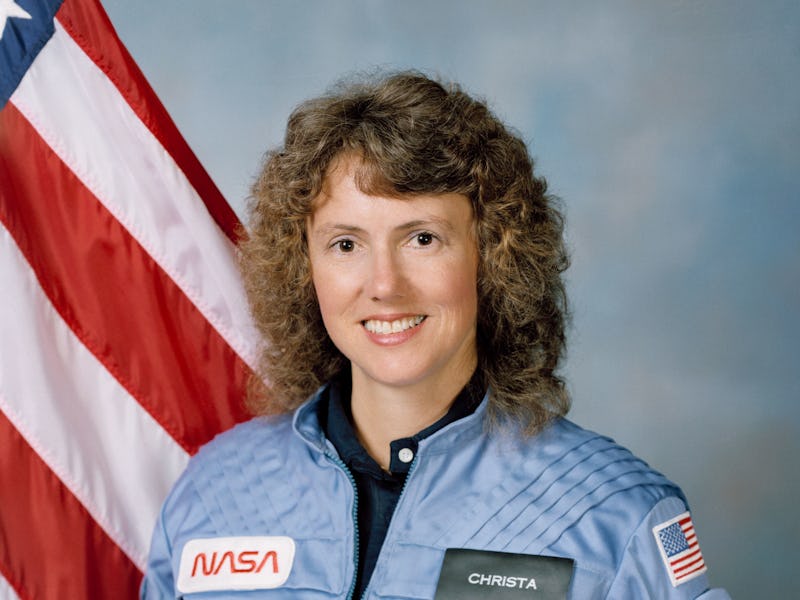What the Challenger Explosion Means 30 Years Later
It's especially important to remember Challenger as we look to Mars.

Thursday marks the 30th anniversary of the day the space shuttle Challenger exploded a mere 72 seconds after launch in the skies off the coast of Cape Canaveral, Florida. The crew of seven — including Christa McAuliffe, who was preparing to be the country’s first teacher to go into space — all perished. It was the first fatal in-air accident in 56 crewed American missions.
It was an incredibly heavy day for the United States, as well as the rest of the world. After 24 successful space shuttle launches, these missions were so routine that the idea of anything bad happening was so far out of the public imagination.
The crew of Space Shuttle mission STS-51-L pose for their official portrait on November 15, 1985
As the subsequent investigation would later reveal, the disaster’s causes weren’t just limited to flaws in the technical engineering and quality control of structural parts and processes in the shuttle, but extended into NASA’s organizational culture and decision-making approaches.
Challenger was set to blast off at 11:38 a.m. on January 28, 1986. It was the shuttle’s tenth mission (STS-51-L), and the second of 16 planned NASA missions — an unusually chaotic year for the space agency. Among those missions included the two shuttle launches in May which would carry planetary probes into space, the first military shuttle flight into polar orbit, launch of the now-renowned Hubble Space Telescope, and sending two private citizens into space.
The first of those was McAuliffe, a New Hampshire high school teacher. She was selected from more than 11,000 applicants to take part in NASA’s Teacher in Space Project. She would have the opportunity to teach two lessons to her students from Challenger as it floated in Earth’s orbit.
As Challenger took off, everything appeared as normal as it always did. Suddenly, at around 46,000 feet above the surface and with a velocity just under Mach 2, the spacecraft exploded into a violent mess of fire and debris. It all happened in an instant. There was no time to attempt an emergency mission abort and get the crew back to the ground safely.
In fact, it wasn’t immediately clear what happened. NASA commentator Steve Nesbitt continued to read off trajectory data from the mission control’s console. After it became plain that there wasn’t any real data coming in, Nesbitt would utter the now-infamous lines:
“Flight controllers here are looking very carefully at the situation. Obviously a major malfunction.”
A wave of shock and grief took over NASA and the crew members’ families. NASA took a 32-month hiatus from shuttle launches. President Ronald Reagan formed a commission (which included famed theoretical physicist Richard Feynman) tasked with looking into the accident over the next several months.
The primary cause, the commission would determine, was the failure of the O-ring seals between two segments in the shuttle’s right solid rocket booster. The resulting breach allowed pressurized burning gas from the solid rocket motor to flow to the outside and apply stress to the adjacent solid rocket booster and external fuel tank. This would eventually lead to the structural failure of the external tank, and aerodynamic forces would initiate the explosion.
Why had the seals been faulty? Simple: Repeated erosion during the previous launches.
But that wasn’t a total surprise to some flight engineers. In fact, the night before Challenger’s flight, engineers with the manufacturer of the solid rocket boosters recommended a delay in launch, since overnight temperatures could make the O-rings too stiff.
Those engineers’ objections, it turns out, were overruled by the company’s managers, who were receiving pressure on their end by NASA officials eager to stick to the year’s heavy launch schedule. The launch went ahead, and disaster struck.
This is a printable version of space shuttle Challenger's orbiter tribute, or OV-099, which hangs in Firing Room 4 of the Launch Control Center at NASA's Kennedy Space Center in Florida.
Obviously, NASA’s most immediate changes were a redesign of the booster fuel segment joints to add a third O-ring and install heaters to keep the seal working under a bigger range of weather conditions. In the long term, NASA improved communications between different groups and personnel within the flight program and slowed down the launch schedule in order to allow more time for pre-flight inspections and increase safety measures.
Though NASA has worked to minimize the possibility of more accidents, there is still an unfortunate risk associated with any kind of crewed spaceflight. The Columbia disaster in 2003 was a stark reminder that something as small and seemingly innocuous as a piece of foam could lead to the worst-case scenario.
And of course, let’s not forget that private spaceflight has run into plenty of hurdles as companies try to develop their space legs.
Still, there’s been tremendous progress made in improving spaceflight safety since Challenger. In the next several decades, as NASA and other space agencies around the world firm up plans to send people out to Mars, the risks associated with space exploration will increase dramatically. This is especially important when we consider spaceflight is opening up to a much wider range of people — including at NASA.
Before her untimely death, McAuliffe once said, “I have a vision of the world as a global village, a world without boundaries.” That’s steadily becoming a reality. We’ll need to stay vigilant to make sure spaceflight — for everyone — is safe enough.